Israel White Patented
Three Arm Plow Plane
Restored patent No. 7951X, January 9,
1834
Serial No. 75
Serial No. 75
What really made this display special was Chris' research into the history of this particular plane as well as detailing the history of it's manufacture. Here is the result of Chris' research into this particular plane. I hope that this is an inspiration to those of us who appreciate the tools that we use for their history as well as their functionality.
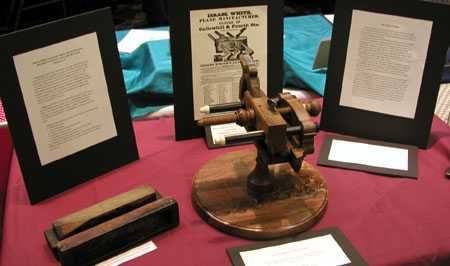 Maker:
Maker:Israel White was born in 1804 and died April 12, 1839. He was part of the White family of plane makers in Philadelphia. (Father, Jacob White; Uncle, Henry G. White; Brother, George White; Wife/Widow Charlotte were all plane makers.) White worked at "CORNER OF CALLOWHILL & FOURTH St." in Philadelphia and often so marked his planes.
If you're using IE 4.0 or higher:
Click on the left and right pages to see images of
Chris' display text in another window.
To View a 512K image of the plane, click
on the plane in the photo at left.
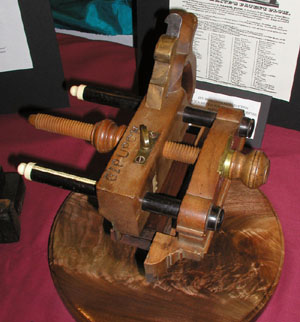 Construction:
Construction:
Beech body, fence,bridle
and wedge. Ebony front and rear arms with ivory tips and inlaid ivory
scale on the front arm. Ivory depth gauge with steel pointer on left side
of plane body. Dovetailed tropical hardwood wear strip in fence.
Eleven inches long (including tote) and 11.5" wide including
the center arm. The threaded center arm is the patented feature, although
the bridle arrangement was not part of the original patent. Serial number
75 stamped on the toe of the plane. Other known examples of the plane
are also stamped "J.S." for James Silcox, a bench hand of White.
This example is not so marked, and thus may well have been made by Israel
White himself. Iron marked "W.Butcher".
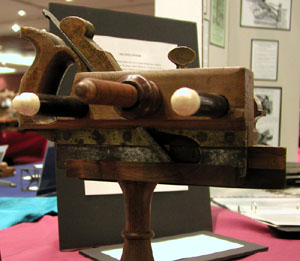 Options:
Options:
Of the ten known examples, various features were incorporated:
1. Unhandled or toted.
2. Ivory or plain tips.
3. With or without ivory fence distance scale.
4. Bridled or traditional fence.
5. Dovetailed or metal rollers on fence for wear protection.
6. With or without depth stop indicator scale.
Thus it appears that White used the
"modern" manufacturing
"pull system" of making planes to the customer's specifications,
perhaps from a standard set of options.

Previous Owners:
This Israel White patented three arm plow
plane has had two owners who imprinted their mark on the plane. One of
these is J. Coulson, of whom no information has been obtained. Coulson
marked the plane three times, on the nose, the bridle and the fence.
Another owner was Bernard Z. Burch
who was born in Ohio on January 30, 1818. He immigrated to Indiana sometime
after 1830 and settled in Logansport in cass County where he was listed
as a cabinet maker in the 1840 Census. In 1850 he was the partner of Israel
neal in the cabinet-making firm of neal and Burch. That year, with Neal
and Burch as the only hands, they produced 100 tables, 30 Bureaus, 600
chairs and 50 beds. While he apparently was successful in the cabinet
making business, there is no listing of him as a cabinet-maker after 1850.
In 1878, he is listed as owning 100 acres of land and in 1880 as being
a farmer.
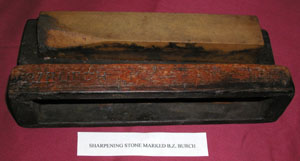 B.Z.
Burch was married at least twice. His first wife Isabella Anderson, died
August 14, 1851 after only 18 months of marriage. Shortly thereafter he
married Marita Burch. Bernard apparently had two children, Erastus Rose,
and Hiram Stoop who are buried in the family lot in the ninth street Cemetery
in Logansport, Indiana. Bernard burch died February 12, 1889 at the age
of 71.
B.Z.
Burch was married at least twice. His first wife Isabella Anderson, died
August 14, 1851 after only 18 months of marriage. Shortly thereafter he
married Marita Burch. Bernard apparently had two children, Erastus Rose,
and Hiram Stoop who are buried in the family lot in the ninth street Cemetery
in Logansport, Indiana. Bernard burch died February 12, 1889 at the age
of 71.Sharpening stone marked B.Z. Burch.
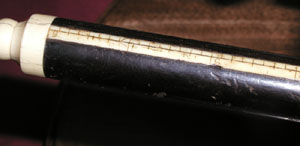
Close up of the ivory fence distance scale.
Assuming
that B.Z. Burch had a traditional seven year apprenticeship, it is likely
that he completed his apprenticeship at the age of 20 or 21. This would
have been in 1838 or 1839, the last two years that Israel White was alive
and produced the patented three arm plow. Thus it is possible that Burch
was the first owner having purchased the plane from israel White himself.
However, this no doubt would have been a costly purchase for the new journeyman.
It is my guess that the unknown J.Coulson was the first owner, and that
B.Z. Burch was the second owner. This speculation is bolstered by the
fact that the plane and the sharpening stone (also marked B.Z. Burch)
were found together, and that the last owner could trace a family friendship
back to Rosie Burch, a descendant of Bernard Z. Burch.